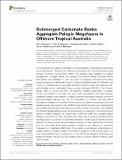Files in this item
Submerged carbonate banks aggregate pelagic megafauna in offshore tropical Australia
Item metadata
| dc.contributor.author | Bouchet, Phil J. | |
| dc.contributor.author | Letessier, Tom B. | |
| dc.contributor.author | Caley, Michael Julian | |
| dc.contributor.author | Nichol, Scott L. | |
| dc.contributor.author | Hemmi, Jan M. | |
| dc.contributor.author | Meeuwig, Jessica J. | |
| dc.date.accessioned | 2020-07-16T09:30:08Z | |
| dc.date.available | 2020-07-16T09:30:08Z | |
| dc.date.issued | 2020-06-30 | |
| dc.identifier | 269101853 | |
| dc.identifier | 1c699772-99b0-4360-84dc-01647002d8da | |
| dc.identifier | 85087855635 | |
| dc.identifier | 000548203400001 | |
| dc.identifier.citation | Bouchet , P J , Letessier , T B , Caley , M J , Nichol , S L , Hemmi , J M & Meeuwig , J J 2020 , ' Submerged carbonate banks aggregate pelagic megafauna in offshore tropical Australia ' , Frontiers in Marine Science , vol. 7 , 530 . https://doi.org/10.3389/fmars.2020.00530 | en |
| dc.identifier.issn | 2296-7745 | |
| dc.identifier.other | crossref: 10.3389/fmars.2020.00530 | |
| dc.identifier.other | ORCID: /0000-0002-2144-2049/work/77131925 | |
| dc.identifier.uri | https://hdl.handle.net/10023/20267 | |
| dc.description | This research was undertaken for the Marine Biodiversity Hub, a collaborative partnership supported through funding from the Australian Government’s National Environmental Research Program (NERP). PB was the recipient of a scholarship for international fees during the course of this work. SN publishes with permission of the Chief Executive Officer, Geoscience Australia. | en |
| dc.description.abstract | The conservation of marine biodiversity is firmly embedded in national and international policy frameworks. However, the difficulties associated with conducting broad-scale surveys of oceanic environments restrict the evidence base available for applied management in pelagic waters. For example, the Oceanic Shoals Australian Marine Park (AMP) was established in 2012 in a part of Australia’s continental shelf where unique topographic features are thought to support significant levels of biodiversity, yet where our understanding of ecological processes remains limited. We deployed mid-water baited remote underwater video systems (mid-water BRUVS) in the Oceanic Shoals AMP to provide the first non-extractive baseline assessment of pelagic wildlife communities in the area. We used these observations and high-resolution multibeam swaths of the seafloor to explore potential relationships between prominent geomorphological features and the (i) composition, (ii) richness, and (iii) relative abundance of pelagic communities. We documented 32 vertebrate species across three sampling areas, ranging from small baitfish to large sharks and rays, and estimated that up to nearly twice as many taxa may occur within the region as a whole. This highlights the Oceanic Shoals AMP as a reservoir of biodiversity comparable to other documented offshore oceanic hotspots. Our results also confirm the AMP as a possible distant foraging destination for IUCN red listed sea turtles, and a potential breeding and/or nursing ground for a number of charismatic cetaceans. Model outputs indicate that both species richness and abundance increase in proximity to raised geomorphic structures such as submerged banks and pinnacles, highlighting the influence of submarine topography on megafauna distribution. By providing a foundational understanding of spatial patterns in pelagic wildlife communities throughout a little studied region, our work demonstrates how a combination of non-destructive sampling techniques and predictive models can provide new opportunities to support decision-making under data shortage. | |
| dc.format.extent | 14 | |
| dc.format.extent | 6452012 | |
| dc.language.iso | eng | |
| dc.relation.ispartof | Frontiers in Marine Science | en |
| dc.subject | Biodiversity | en |
| dc.subject | Northwest Australia | en |
| dc.subject | Pelagic species | en |
| dc.subject | Geomorphology | en |
| dc.subject | Seabed topography | en |
| dc.subject | Mid-water BRUVS | en |
| dc.subject | Submerged banks and shoals | en |
| dc.subject | QH301 Biology | en |
| dc.subject | DAS | en |
| dc.subject | SDG 14 - Life Below Water | en |
| dc.subject.lcc | QH301 | en |
| dc.title | Submerged carbonate banks aggregate pelagic megafauna in offshore tropical Australia | en |
| dc.type | Journal article | en |
| dc.contributor.institution | University of St Andrews. School of Mathematics and Statistics | en |
| dc.contributor.institution | University of St Andrews. School of Biology | en |
| dc.contributor.institution | University of St Andrews. Centre for Research into Ecological & Environmental Modelling | en |
| dc.identifier.doi | 10.3389/fmars.2020.00530 | |
| dc.description.status | Peer reviewed | en |
This item appears in the following Collection(s)
Items in the St Andrews Research Repository are protected by copyright, with all rights reserved, unless otherwise indicated.

